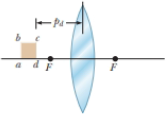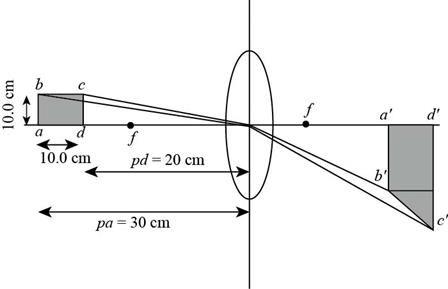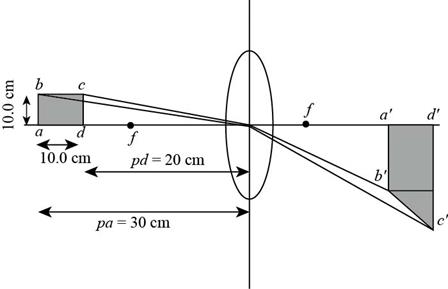
Concept explainers
In Figure P35.30, a thin converging lens of focal length 14.0 cm forms an image of the square abed, which is he = hb = 10.0 cm high and lies between distances of pd = 20.0 cm and pa = 30.0 cm from the lens. Let a′, b′, c′. and d′ represent the respective corners of the image. Let qa represent the image distance for points a′ and b′, qd represent the image distance for points c′ and d′,
where h′ and q are in centimeters. (d) Explain why the geometric area of the image is given by
(e) Carry out the integration to find the area of the image.
Figure P35.30

(a)
Answer to Problem 36.50P
Explanation of Solution
Given info: The focal length of the lens is
Formula to calculate the image of any object in a thin lens is,
Here,
Substitute
Here,
Substitute
Substitute
Here,
Substitute,
Formula to calculate the height of the corresponding image point

Here,
Substitute
For calculating the image height corresponding to
Substitute
Conclusion:
Therefore, the values of
(b)
To draw: The sketch of the ray diagram.
Answer to Problem 36.50P

Explanation of Solution
The image of the square

Figure (1)
(c)
To show: The relation,
Answer to Problem 36.50P
Explanation of Solution
Here,
From the lens,
Here,
Substitute
Substitute
Conclusion:
Therefore the relation between height of the image and the image distance is
(d)
To write: The explanation that the geometric area of image is
Answer to Problem 36.50P
Explanation of Solution
Given info: The geometric area of a image is,
Here,
From equation (10) the integral sums up the small areas of region covered by the image itself. The height of the small regions is
Therefore area of that small region is
Therefore the integration from
Conclusion:
Therefore, the geometric area of the image is given by integral
(e)
Answer to Problem 36.50P
Explanation of Solution
Given info: The geometric area of the image is given by the integral,
From equation (9) substitute
Integrate the above equation with respect to
Conclusion:
Therefore, the geometric area of the image is
Want to see more full solutions like this?
Chapter 36 Solutions
EBK PHYSICS FOR SCIENTISTS AND ENGINEER
- Part C Find the height yi from which the rock was launched. Express your answer in meters to three significant figures. Learning Goal: To practice Problem-Solving Strategy 4.1 for projectile motion problems. A rock thrown with speed 12.0 m/s and launch angle 30.0 ∘ (above the horizontal) travels a horizontal distance of d = 19.0 m before hitting the ground. From what height was the rock thrown? Use the value g = 9.800 m/s2 for the free-fall acceleration. PROBLEM-SOLVING STRATEGY 4.1 Projectile motion problems MODEL: Is it reasonable to ignore air resistance? If so, use the projectile motion model. VISUALIZE: Establish a coordinate system with the x-axis horizontal and the y-axis vertical. Define symbols and identify what the problem is trying to find. For a launch at angle θ, the initial velocity components are vix=v0cosθ and viy=v0sinθ. SOLVE: The acceleration is known: ax=0 and ay=−g. Thus, the problem becomes one of…arrow_forwardPhys 25arrow_forwardPhys 22arrow_forward
 Physics for Scientists and EngineersPhysicsISBN:9781337553278Author:Raymond A. Serway, John W. JewettPublisher:Cengage Learning
Physics for Scientists and EngineersPhysicsISBN:9781337553278Author:Raymond A. Serway, John W. JewettPublisher:Cengage Learning Physics for Scientists and Engineers with Modern ...PhysicsISBN:9781337553292Author:Raymond A. Serway, John W. JewettPublisher:Cengage Learning
Physics for Scientists and Engineers with Modern ...PhysicsISBN:9781337553292Author:Raymond A. Serway, John W. JewettPublisher:Cengage Learning Principles of Physics: A Calculus-Based TextPhysicsISBN:9781133104261Author:Raymond A. Serway, John W. JewettPublisher:Cengage Learning
Principles of Physics: A Calculus-Based TextPhysicsISBN:9781133104261Author:Raymond A. Serway, John W. JewettPublisher:Cengage Learning Physics for Scientists and Engineers: Foundations...PhysicsISBN:9781133939146Author:Katz, Debora M.Publisher:Cengage Learning
Physics for Scientists and Engineers: Foundations...PhysicsISBN:9781133939146Author:Katz, Debora M.Publisher:Cengage Learning University Physics Volume 3PhysicsISBN:9781938168185Author:William Moebs, Jeff SannyPublisher:OpenStax
University Physics Volume 3PhysicsISBN:9781938168185Author:William Moebs, Jeff SannyPublisher:OpenStax Glencoe Physics: Principles and Problems, Student...PhysicsISBN:9780078807213Author:Paul W. ZitzewitzPublisher:Glencoe/McGraw-Hill
Glencoe Physics: Principles and Problems, Student...PhysicsISBN:9780078807213Author:Paul W. ZitzewitzPublisher:Glencoe/McGraw-Hill





